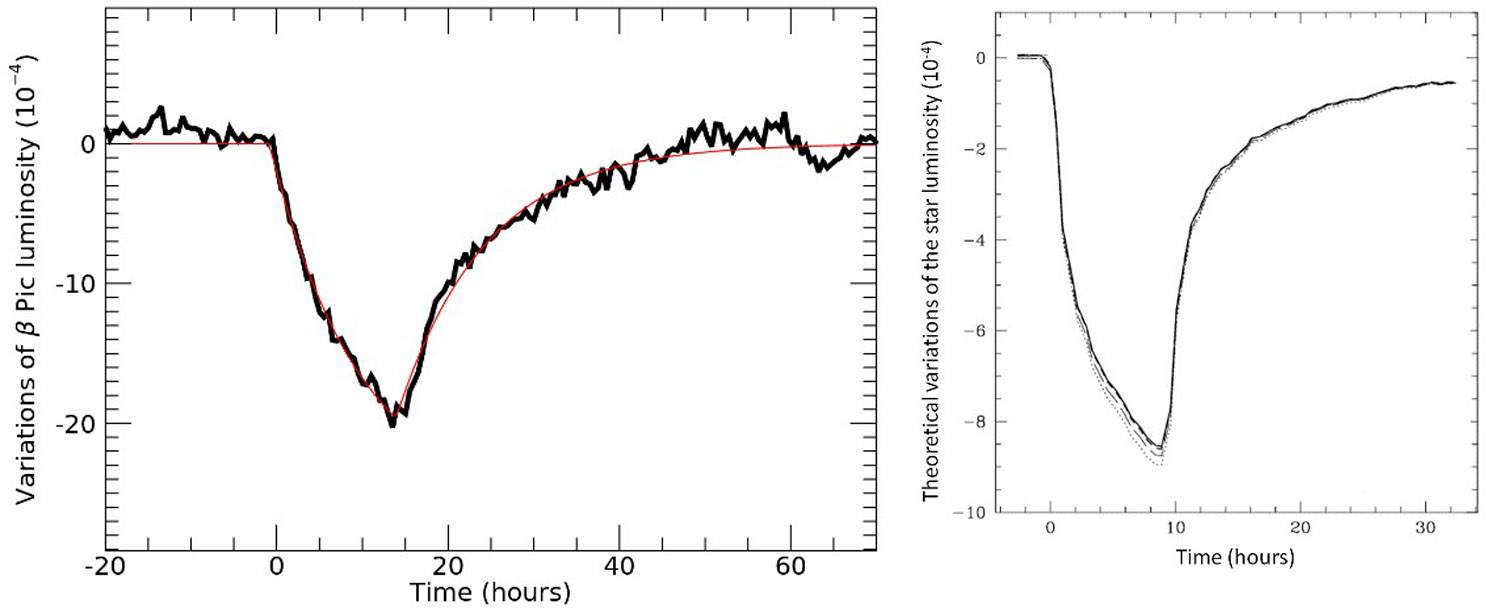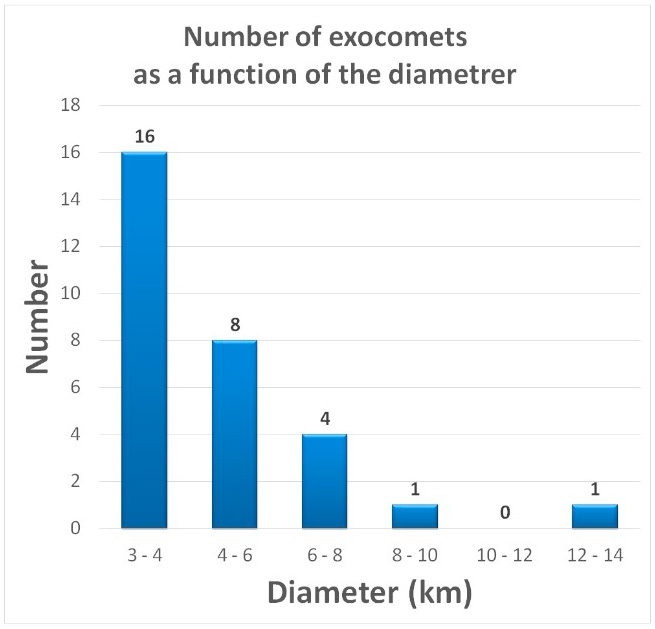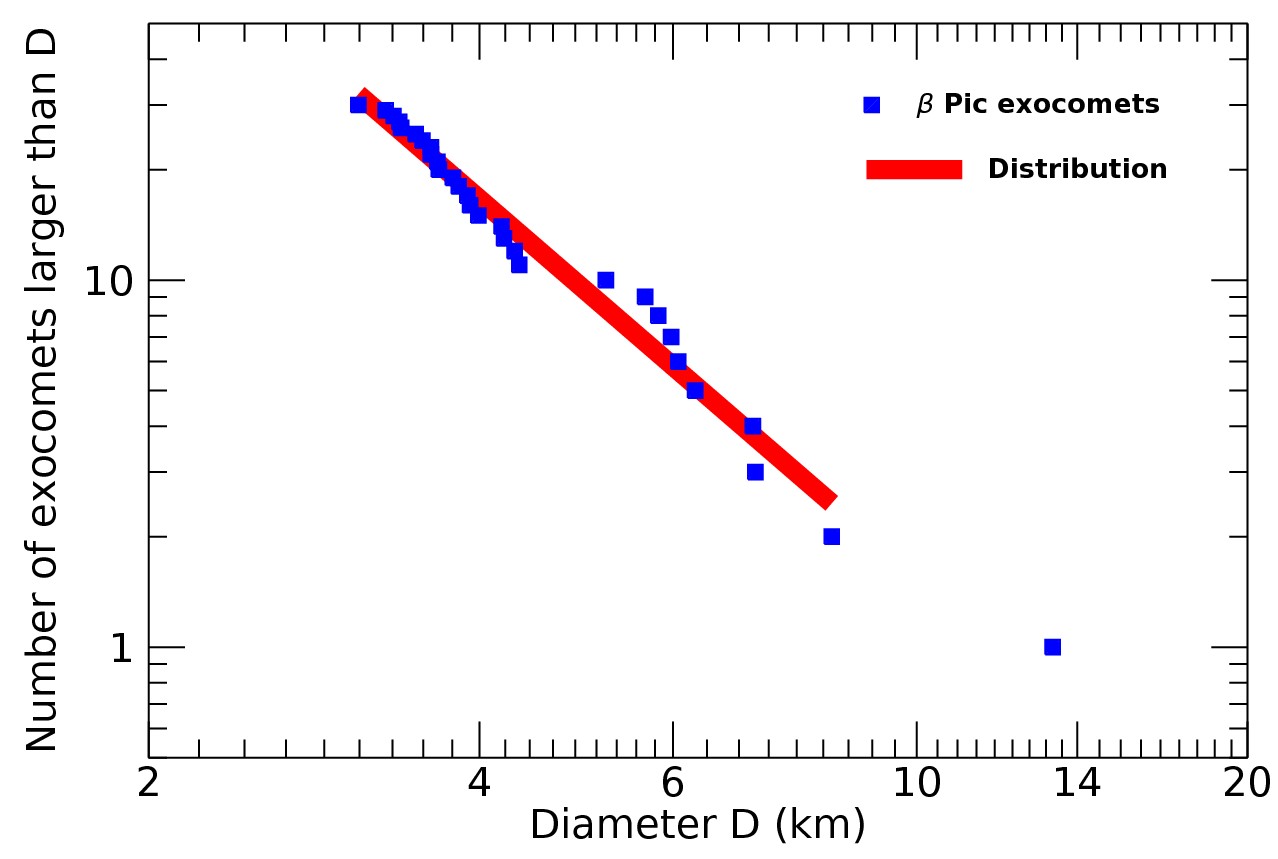DISCOVERY OF 30 EXOCOMETS IN THE YOUNG PLANETARY SYSTEM OF Β PICTORIS
The star β Pictoris hosts a young planetary system that is characterized by the presence of a disk of gas and dust, at least two massive planets, and numerous asteroids and comets. With the analysis of the whole set of observations of β Pictoris obtained with the NASA Transiting Exoplanet Survey Satellite (TESS), 30 transits of exocomets were identified. The measurement of the amount of dust produced by these comets has allowed, for the first time in an extrasolar system, the estimation of the size of cometary nuclei which are between 3 and 14 kilometers in diameter. The size of the comets and its distribution between small and large cometary nuclei show a striking similarity with those of comets observed in the solar system. This result shows that these exocomets are the result of collisions and fragmentation processes.
 Fig. 1: Artist's impression of the exocomets in orbit around the star β Pictoris.
Fig. 1: Artist's impression of the exocomets in orbit around the star β Pictoris.
In this illustration the red diffuse band represents the dust disk surrounding the star β Pictoris, visible as a dazzling spot. The tails of dust and gas escaping from cometary nuclei form trails in the opposite direction to the direction of the star because of the radiation pressure pushing the gas particles and dust grains out of the system.
Credit: ESO/L. Calçada (https://www.eso.org/public/images/eso1432a)
The planetary system of β Pictoris (Fig. 1) is only about 20 million years old, which is very young compared to the 4.5 billion years of the solar system. Its observation provides crucial information to understand the final phases of planetary formation and the interactions between all the bodies that compose it: planets and small bodies such as asteroids and comets. For more than thirty years, exocomets have been observed in β Pictoris thanks to the spectroscopy which allows to detect the gas present in the cometary tails. But the detection of dust tails is much more difficult because it requires very high precision photometric observations. These observations have been made possible by the NASA's Transiting Exoplanet Survey Satellite.
This work was carried out by a team led by Alain Lecavelier des Etangs, CNRS researcher at the Institut d'astrophysique de Paris (CNRS, Sorbonne University) with a student from the École nationale supérieure des mines de Paris, researchers from the Institut d'astrophysique de Paris, from the Observatoire de Haute Provence, the Laboratorio Nacional de Astrofísica in Brazil, the Laboratoire d'études spatiales et d'instrumentation en astrophysique (Observatoire de Paris-CNRS, Paris Sciences et Lettres, Sorbonne Université, Université Paris Cité), the Leiden Observatory in the Netherlands, and the Institut de planétologie et d'astrophysique de Grenoble (Université Grenoble Alpes - CNRS). The analysis of the observations collected by the TESS satellite allowed the measurement of the size of the nuclei of these 30 comets which are between 3 and 14 kilometers in diameter. The article is published by Scientific Reports (Springer Nature).
These comets were detected by the method known as “transits”, that is to say by observing the decrease in brightness of a star when an object in orbit passes on the line of sight between the Earth and the star, partially occulting this star. In this case, the light curve, i.e. the shape of the graph that represents the luminosity of the star as a function of time, is quite particular, in the form of a “rounded triangle” (see Fig. 2). This shape had been predicted more than twenty years ago (in 1999) by Alain Lecavelier and his collaborators, which makes it possible to identify without any doubt that these are transits of exocomets. The decrease of luminosity being due to the occultation by the dust of the cometary tail, its measurement makes it possible to quantify the rate of dust production by evaporation of the nucleus of each comet and to deduce its size.
 Fig. 2: Light curves of an exocomet transit, as predicted and observed for β Pictoris.
Fig. 2: Light curves of an exocomet transit, as predicted and observed for β Pictoris.
The left plot shows the light curve of β Pictoris observed with TESS during the passage of an exocomet in front of this star on January 2, 2019 (Lecavelier des Etangs et al. 2022; see also Zieba et al. 2019; Pavlenko et al. 2022). The right plot shows the theoretical light curve predicted more than 20 years ago by A. Lecavelier des Etangs, A. Vidal-Madjar & R. Ferlet (Astronomy & Astrophysics 1999).
Credit: A. Lecavelier des Etangs (IAP-CNRS)
 Fig. 3: Distribution of the size of exocomets discovered in the β Pictoris planetary system.
Fig. 3: Distribution of the size of exocomets discovered in the β Pictoris planetary system.
While 16 exocomets are between 3 and 4 kilometers in diameter, only 4 have a diameter between 6 and 8 kilometers and only one comet has a diameter between 8 and 10 kilometers. This rapid decrease in the number of objects for large sizes is characteristic of objects produced by collision and fragmentation.
Credit: A. Lecavelier des Etangs (IAP-CNRS)
Even better, the large number of detections allows to determine the size distribution of exocomets, i.e. how many small comets there are relative to the number of large comets: the cometary nuclei of the thirty detected objects are between 3 and 14 kilometers in diameter (see Fig. 3). This is the first time that the size distribution of small bodies is measured in an extrasolar system: it is only the second planetary system after the solar system for which we have information on the size distribution of objects other than the planets that it harbors.
The knowledge of the size distribution of comets and asteroids is important because this distribution is the result of processes that took place during planetary formation, in particular the competition between the agglomeration of small bodies (called planetesimals) to form larger ones and the fragmentation of larger bodies into smaller fragments during collisions. This is why many works have been carried out to measure precisely the size distribution of small bodies in the Solar System.
 Fig. 4: Exocomet size distribution in the β Pictoris planetary system.
Fig. 4: Exocomet size distribution in the β Pictoris planetary system.
The size of each of the 30 exocomets is shown by a blue square. The red line indicates the expected distribution for a population of objects produced by collisions as predicted by J. Dohnanyi en 1969.
Credit: A. Lecavelier des Etangs (IAP-CNRS)
In the paper published in Scientific Reports by Springer Nature, it is shown that the size of exocometary nuclei in the β Pictoris planetary system is surprisingly similar to that of Solar System comets. Moreover, the observed distribution in β Pictoris is consistent with that expected in the case of a comet population formed by cascades of collisions and fragmentations (see Fig. 4).
This new result shows the importance of collisions in the processes that determine the size of comets. Knowing that the fall of comets on the Earth is a possible mechanism to explain the origin of water on our planet, the similarity of the history of comets in the planetary system of β Pictoris and in the Solar System is of importance. This work illustrates the role of the interactions between planets and small bodies such as asteroids or comets, to determine the physiognomy of planetary systems and the history of the objects which compose them.
Link
![]() Article in Nature: Lecavelier des Etangs, A., Cros, L., Hébrard, G. et al. “Exocomets size distribution in the β Pictoris planetary system” Scientific Reports 12, 5855 (2022) (Public version)
Article in Nature: Lecavelier des Etangs, A., Cros, L., Hébrard, G. et al. “Exocomets size distribution in the β Pictoris planetary system” Scientific Reports 12, 5855 (2022) (Public version)
Writing and contacts
- Alain Lecavelier
Institut d’astrophysique de Paris, CNRS, Sorbonne Université
lecaveli [at] iap [dot] fr
Web writing: Valérie de Lapparent
Layout and iconography: Jean Mouette
June 2022
